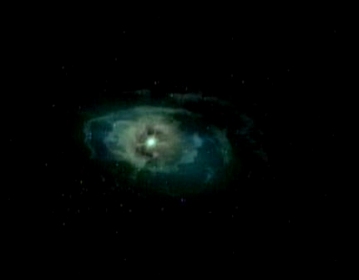|

In Star Trek, a micro-wormhole is a wormhole of very
small size. A micro- wormhole could have originally been of a much
greater size, but is in an advanced state of collapse, and over time
degraded and shrunk to a smaller size. It is a wormhole whose
singularity has mostly dissipated, collapsing and leaving an extremely
narrow passageway through subspace. In 2371, the USS Voyager discovered
a naturally-occurring micro-wormhole thirty centimeters in diameter
which led from the Delta Quadrant to Romulan space (20 years in the
past). (VOY: "Eye of the Needle"). In 2376, the Pathfinder Project at
Starfleet Communications was able to create a temporary, artificial
micro-wormhole using the MIDAS array, to briefly communicate with
Voyager over 30,000 light years away in the Delta Quadrant. (VOY:
"Pathfinder").
In physics, a wormhole is a hypothetical topological
feature of spacetime that is fundamentally a 'shortcut' through space
and time. Spacetime can be viewed as a 2D surface, and when 'folded'
over, a wormhole bridge can be formed. A wormhole has at least two
mouths which are connected to a single throat or tube. If the wormhole
is traversable, matter can 'travel' from one mouth to the other by
passing through the throat. While there is no observational evidence
for wormholes, spacetimes-containing wormholes are known to be valid
solutions in general relativity.
However, a study in 2005 by Chris Fewster, of the
University of York, UK, and Thomas Roman, of Central Connecticut State
University, US, demonstrated that even if it were possible for humans
to build such wormholes, they would probably be too small to fit
spacecraft or even humans and could probably only be possible at the
scale of Star Trek's micro-wormholes. The study analysed the proposal
that wormhole throats could be kept open using arbitrarily small
amounts of exotic matter. Exotic matter is a hypothetical concept of
particle physics and refers to any material which violates one or more
classical conditions or is not made of known baryonic particles. Such
materials would possess qualities like negative mass or being repelled
rather than attracted by gravity.
Fewster and Roman calculated that, even if it were
possible to build a wormhole, its throat would probably be too small
for time travel. It might - in theory - be possible to carefully
fine-tune the geometry of the wormhole so that the wormhole throat
became big enough for a person to fit through. But building a wormhole
with a throat radius big enough to just fit a proton would require
fine-tuning to within one part in 10 to the power of 30. A human-sized
wormhole would require fine-tuning to within one part in 10 to the
power of 60.
It is currently speculated that tiny quantum wormholes -
at the level of quarks and electrons - may exist for short periods of
time. But most experts suspect that some fundamental law of physics
prevents the formation of large wormholes. Wormholes that were large
enough for humans to travel through would need to be crammed with
'exotic matter' to keep them open.
However, a Russian expert in relativity, Sergei
Krasnikov of the Pulkovo Observatory in St Petersburgh has developed a
new type of wormhole model that is compatible with the known laws of
physics, yet can be as big and stable as you like. His wormholes create
their own exotic matter out of nothing when space and time are curved
in the right way, in sufficient quantities to make it big enough and
keep it open long enough for people to use. This wormhole actually
generates enough to make it arbitrarily large. However, Krasnikov
accepts that testing his claims by building a wormhole is far beyond
present technology.
|
|
